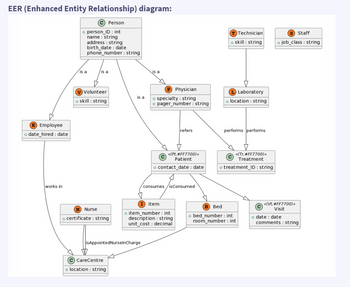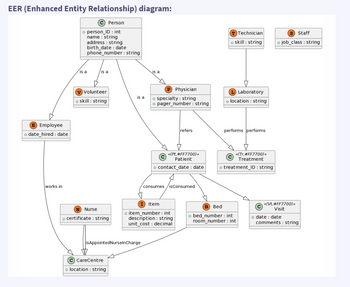tudy the information provided and then answer the questions that follow. For a long time, the Royal Victoria Hospital (RVH) worked with an information system that consisted of a mix of paper-based files and small independent databases developed within some departments. The new administration created an information system (IS) department and hired you as information officer: head of the team in charge of the design and implementation of a new global information system. The first team from the IS department conducted interviews with some hospital administration and staff to identify entity types for the hospital. The following information was collected by this team. The hospital depends primarily on four groups of people: employees, physicians, patients, and volunteers. Of course, some common attributes are shared by all these groups: person_ID (identifier), name, address, birth date, and phone number. Each group also has at least one unique attribute of its own. Employees have a date hired, volunteers have a skill, physicians have a specialty and a pager number, and patients have a contact date (date of first contact with the hospital). Some people may belong to two or more groups at a given time (e.g., patient and volunteer). Patient: A person who is either admitted to the hospital or is registered in an outpatient program. One, and only one, physician is responsible for each patient. Patients are divided into two groups: resident and outpatient. Each outpatient is scheduled for zero or more visits. The entity visit has two attributes: date (partial identifier) and comments. Note that an instance of visit cannot exist without an outpatient owner entity. Only resident patients are assigned to a bed, and a bed may or may not be assigned to a patient. Physician: A member of the hospital staff who may admit patients to the hospital and who can administer medical treatments. A given physician can be responsible for zero or more patients at a given time. A patient must be referred to the hospital by exactly one physician. A physician can refer any number of patients or may not refer any patients. Physicians may perform any number of treatments on behalf of any number of patients or may not perform any treatment. A patient may have treatments performed by any number of physicians. For each treatment performed on behalf of a given patient by a particular physician, the hospital records the treatment date, treatment time, and results. Employee: Any person employed as part of the hospital staff. Employees are subdivided into three groups: nurse, staff, and technician. Only nurse has the attribute certificate, which indicates a qualification (e.g., RN, LPN). Only staff has the attribute job class, and only technician has the attribute skill. Each nurse is assigned to one (and only one) care centre. Each technician is assigned to one or more laboratories. Care centre: A treatment centre within the hospital. Examples of care centres are maternity, emergency, and cardiology. Attributes of care centre are name (identifier) and location. A care centre may have one or more nurses assigned to it. Also, one of the nurses assigned to each care centre is appointed nurse-in-charge. A nurse cannot be appointed nurse-in-charge of a care centre unless they have an RN certificate. Each hospital employee is assigned to work in one or more care centres. Each care centre has at least one employee and may have any number of employees. The hospital records the number of hours per week that a given employee works in a particular care centre. Each physician can be assigned to one or more care centres, and a care centre can have one or more physicians assigned to it. Laboratory: A unit in the hospital where clinical tests (e.g., blood, urine, tissue) are performed to obtain information about the health of a patient. Attributes of laboratory include name (identifier) and location. A laboratory must have one or more technicians assigned to it. Bed: A hospital bed that may be assigned to a resident patient who is admitted to the hospital. Each bed has a bed number, a room number, and a care centre ID. There may be no bed assigned to a care centre, or a care centre may have one or more beds assigned to it. Item: Any medical or surgical item that is used in treating a patient. Each item has an item number, description, and unit cost. A patient may optionally consume any number of items. A given item may be consumed by one or more patients or may not be consumed. For each item consumed by a patient, the hospital records the date, time, quantity, and total cost (which can be computed by multiplying quantity by unit cost). Treatment: Any test or procedure performed by a physician on behalf of a patient. Each treatment has a treatment ID, which consists of a treatment number and a treatment name. Is the ability to model subtype/supertype relationships likely to be important in a hospital environment such as RVH? Justify your answer.
Study the information provided and then answer the questions that follow.
For a long time, the Royal Victoria Hospital (RVH) worked with an
- The hospital depends primarily on four groups of people: employees, physicians, patients, and volunteers. Of course, some common attributes are shared by all these groups: person_ID (identifier), name, address, birth date, and phone number. Each group also has at least one unique attribute of its own. Employees have a date hired, volunteers have a skill, physicians have a specialty and a pager number, and patients have a contact date (date of first contact with the hospital). Some people may belong to two or more groups at a given time (e.g., patient and volunteer).
- Patient: A person who is either admitted to the hospital or is registered in an outpatient program. One, and only one, physician is responsible for each patient. Patients are divided into two groups: resident and outpatient. Each outpatient is scheduled for zero or more visits. The entity visit has two attributes: date (partial identifier) and comments. Note that an instance of visit cannot exist without an outpatient owner entity. Only resident patients are assigned to a bed, and a bed may or may not be assigned to a patient.
- Physician: A member of the hospital staff who may admit patients to the hospital and who can administer medical treatments. A given physician can be responsible for zero or more patients at a given time.
- A patient must be referred to the hospital by exactly one physician. A physician can refer any number of patients or may not refer any patients.
- Physicians may perform any number of treatments on behalf of any number of patients or may not perform any treatment. A patient may have treatments performed by any number of physicians. For each treatment performed on behalf of a given patient by a particular physician, the hospital records the treatment date, treatment time, and results.
- Employee: Any person employed as part of the hospital staff. Employees are subdivided into three groups: nurse, staff, and technician. Only nurse has the attribute certificate, which indicates a qualification (e.g., RN, LPN). Only staff has the attribute job class, and only technician has the attribute skill. Each nurse is assigned to one (and only one) care centre. Each technician is assigned to one or more laboratories.
- Care centre: A treatment centre within the hospital. Examples of care centres are maternity, emergency, and cardiology. Attributes of care centre are name (identifier) and location. A care centre may have one or more nurses assigned to it. Also, one of the nurses assigned to each care centre is appointed nurse-in-charge. A nurse cannot be appointed nurse-in-charge of a care centre unless they have an RN certificate.
- Each hospital employee is assigned to work in one or more care centres. Each care centre has at least one employee and may have any number of employees. The hospital records the number of hours per week that a given employee works in a particular care centre. Each physician can be assigned to one or more care centres, and a care centre can have one or more physicians assigned to it.
- Laboratory: A unit in the hospital where clinical tests (e.g., blood, urine, tissue) are performed to obtain information about the health of a patient. Attributes of laboratory include name (identifier) and location. A laboratory must have one or more technicians assigned to it.
- Bed: A hospital bed that may be assigned to a resident patient who is admitted to the hospital. Each bed has a bed number, a room number, and a care centre ID. There may be no bed assigned to a care centre, or a care centre may have one or more beds assigned to it.
- Item: Any medical or surgical item that is used in treating a patient. Each item has an item number, description, and unit cost.
- A patient may optionally consume any number of items. A given item may be consumed by one or more patients or may not be consumed. For each item consumed by a patient, the hospital records the date, time, quantity, and total cost (which can be computed by multiplying quantity by unit cost).
- Treatment: Any test or procedure performed by a physician on behalf of a patient. Each treatment has a treatment ID, which consists of a treatment number and a treatment name.
- Is the ability to model subtype/supertype relationships likely to be important in a hospital environment such as RVH? Justify your answer.
Step by step
Solved in 4 steps

Map the EER diagram to a relational schema and transform the relation into 3NF

Why are entity integrity and referential integrity constraints of importance to RVH
Is there any opportunity for using entity clustering in the RVH EER diagram? Justify your answer

Is there any opportunity for using entity clustering in the RVH EER diagram? Justify your answer.
Draw an EER diagram to accurately represent this set of requirements. State any assumption you had to make in developing the diagram.
3. Do there appear to be any weak entities in the description of the data requirements in this project module? Justify your answer
2. Can the business rules paradigm, and the ability to easily define, implement, and maintain business rules, be used as a competitive advantage in a hospital environment such as RVH? Justify your answer.








